Hey there, fellow dog enthusiasts! We’ve all been there, haven’t we? You’re out by the lake, enjoying the fresh air, and suddenly, your furry friend decides to take a little impromptu sip from the water.
It’s a classic move in the doggy playbook, right up there with ‘roll in the mud’ and ‘chase your own tail for no apparent reason’. But here’s the thing, folks: that seemingly harmless gulp of lake water might not be as innocent as it seems.
Now, don’t get me wrong, lakes can be an absolute blast for our four-legged companions.
If your dog drinks lake water, immediately remove them from the water. Prevent further ingestion, rinse with clean water if possible, and observe for any unusual symptoms. Contact your vet if symptoms persist or worsen.
The open space, the freedom to explore, and the abundance of exciting smells can turn any pup into a temporary canine explorer. But, and it’s a big ‘but’, there are hidden dangers lurking beneath those shimmering waves.
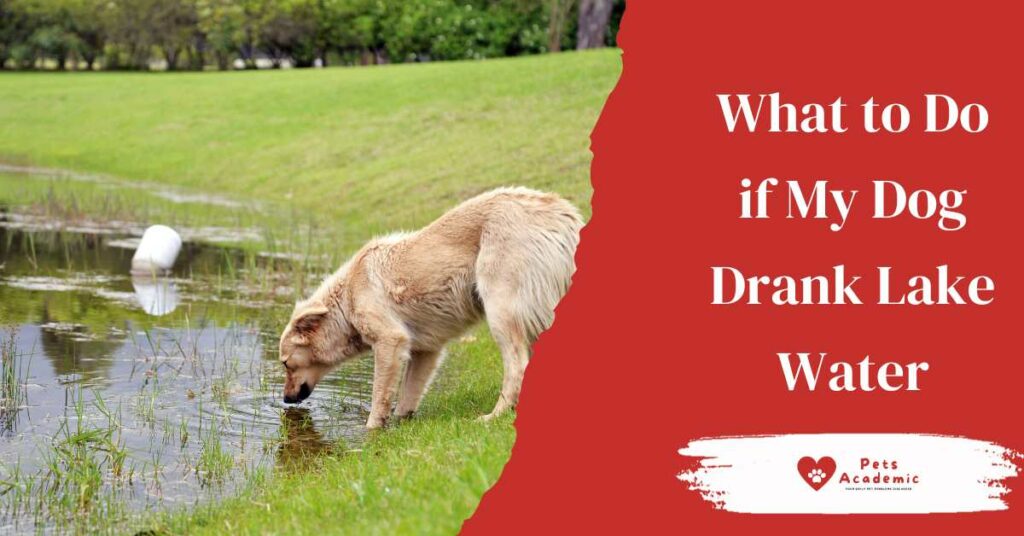
Also read: Why does my dog gag after drinking water?
What is So Hazardous About Lake Water?
Alright, let’s get down to the nitty-gritty of why lake water can be a bit of a wild card for your pup. It’s not just your regular H2O, oh no, it’s a complex ecosystem with its own set of surprises.
Algae Blooms and Cyanobacteria: Nature’s Neon Party
Ever heard of an algae bloom? It’s like the Coachella of the microscopic world, only instead of music, it’s a vibrant explosion of algae. These colorful clusters can turn a once-clear lake into a psychedelic dreamscape. While it might look like a scene out of a trippy music video, it’s a clear sign that things have gone a bit haywire.
Now, here’s where it gets serious.
Some types of algae, particularly a group known as cyanobacteria, can produce toxins. These are like the unwelcome guests crashing the party, bringing a whole load of trouble with them.
When ingested, these toxins can wreak havoc on your dog’s digestive system, nervous system, and even liver.
Bacteria, Parasites, and Protozoa: The Uninvited Guests
Just when you thought it couldn’t get more complicated, enter the bacteria, parasites, and protozoa. They’re the freeloaders of the lake party, hitching a ride on any unsuspecting dog that decides to take a sip.
E. coli, giardia, and a host of other not-so-friendly critters can set up shop in lake water. If your pup swallows these nasties, it can lead to a bout of gastrointestinal upset that nobody—human or canine—wants to deal with.
Chemical Pollutants and Toxins: The Silent Saboteurs
Let’s not forget the silent troublemakers: chemical pollutants and toxins. Whether from runoff, industrial activity, or other human interference, lakes can sometimes play host to a cocktail of chemicals that are definitely not on the menu for your dog.
These can range from heavy metals to pesticides, and they have no business being in your pup’s system. Ingesting them can lead to a range of health issues, depending on the specific chemicals involved.
Now, I know this all sounds like a lot to take in, but don’t panic just yet! In the next section, we’ll talk about the potential effects of your dog drinking lake water and what to watch out for. Stay tuned!
Meanwhile, if you are wondering what to do if my dog drinks dirty water, you can read all about that in this article I have written.
Effects of Drinking Lake Water on Dogs
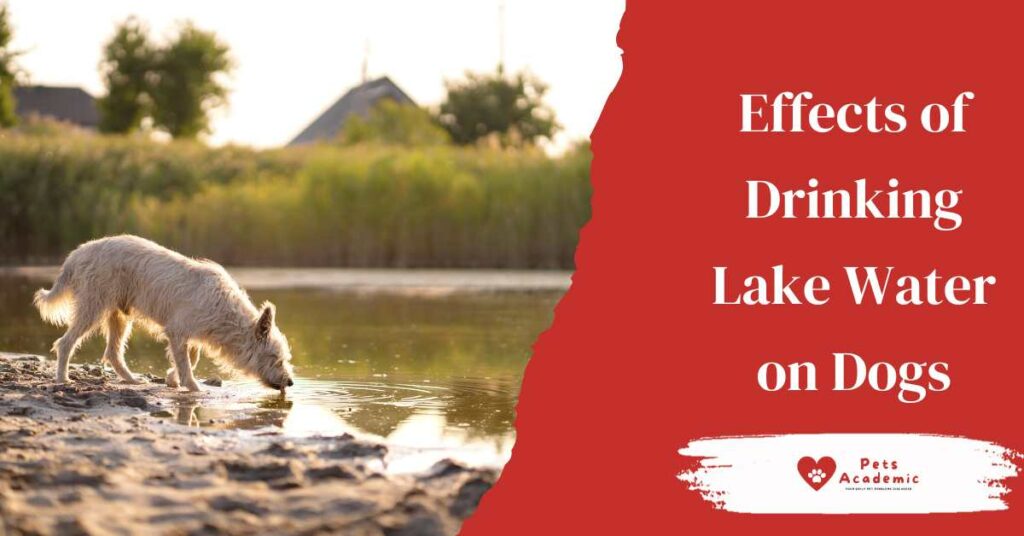
All right, let’s get real about what happens when your pup decides to indulge in a little lakeside refreshment. It’s not all sunshine and rainbows, folks.
Immediate Risks of Ingestion: A Splash of Trouble
So, your furry adventurer took a swig of lake water. What’s the worst that could happen? Well, depending on what’s lurking in those waters, quite a bit. From upset stomachs and vomiting to diarrhea that could rival a category 5 hurricane, it’s not a pleasant experience for your pup.
And let’s not forget the potential for skin irritations if the water is harboring any unfriendly critters. Your pup might come out of that swim with a not-so-fashionable rash. Not exactly the aquatic adventure they were hoping for, huh?
Potential Long-Term Health Implications: The Sneaky Aftermath
Now, here’s where things get a bit tricky. While your dog might seem fine immediately after their aquatic escapade, there could be some long-term effects brewing beneath the surface.
Repeated exposure to certain contaminants in lake water can lead to chronic health issues. Think liver problems, nervous system disorders, and even an increased risk of certain types of cancer.
It’s like a slow burn, and by the time symptoms appear, it could be a serious situation.
But hey, I’m not here to scare you off lakes forever. With the right knowledge and precautions, you can still enjoy those lakeside adventures with your pup.
In the next section, we’ll chat about the common symptoms to keep an eye out for, so you’ll know when it’s time to take action. Stay tuned, because we’re about to decode your dog’s body language like never before!
Common Symptoms to Watch For
Alright, let’s get into the nitty-gritty of what to look out for after your pup has had its unexpected gulp of lake water. Your furry friend might not be able to speak human, but their body has a way of sending signals. Here’s what to keep an eye on:
Gastrointestinal Distress: The Tummy Troubles
Watch out for any signs of digestive distress. This could include vomiting, diarrhea, or a sudden loss of appetite. Your pup might be trying to tell you that its stomach isn’t exactly on speaking terms with that lake water.
Neurological Symptoms: The Brain Teasers
Keep an eye out for any unusual behavior or changes in coordination. If your dog starts acting wobbly, disoriented, or shows signs of tremors, it’s a red flag. These could be indicators that something not-so-great made its way into their system.
Respiratory Issues: The Breathless Dilemma
Pay attention to your pup’s breathing. If they start coughing, wheezing, or seem to have trouble catching their breath, it’s time to sit up and take notice. Respiratory problems can be a serious sign of trouble.
Dermatological Reactions: The Itchy, Scratchy Situation
Check for any skin irritations or rashes. If your dog starts scratching excessively or shows signs of redness or swelling, it could be a sign that the lake water had some unwelcome guests.
Remember, dogs can’t text you their symptoms or give you a detailed report. It’s up to us to be keen observers and protectors of our furry friends. If you notice any of these signs, don’t panic; we’ve got a plan.
In the next section, we’ll talk about what immediate actions you can take to help your pup out. So, stay tuned for some doggy first aid 101!
Immediate Actions After Your Dog Drinks Lake Water
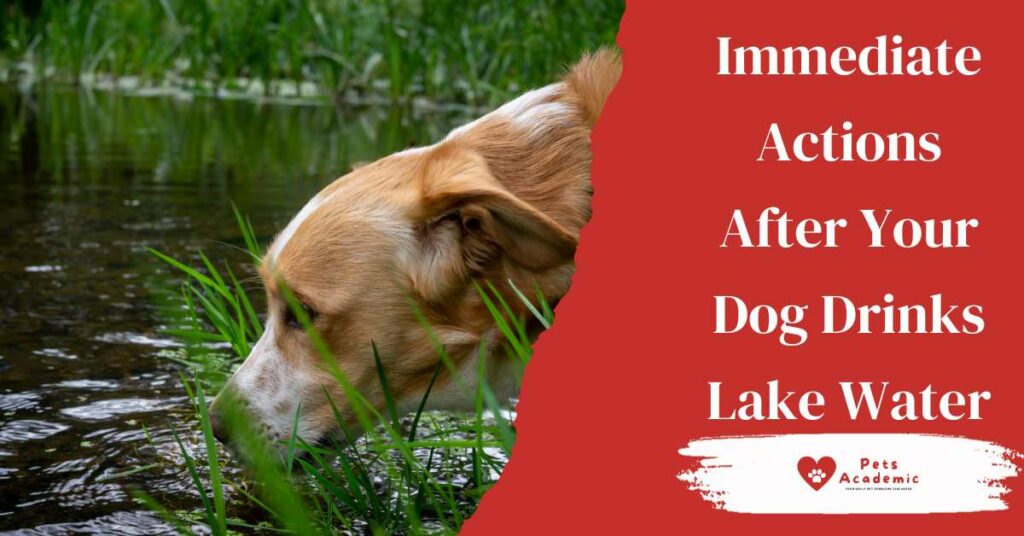
Alright, quick thinkers, it’s time to spring into action! If your furry friend decides to indulge in a spontaneous lake water tasting, here’s what you need to do, pronto:
1. Remove Your Dog from the Water: Swift and Gentle
First things first, gently and swiftly guide your pup away from the water. We want to minimize any further ingestion of potentially harmful substances.
2. Prevent Further Ingestion: Play Defense
If your dog is still feeling adventurous, make sure they steer clear of the water. This might require a little extra vigilance on your part, but hey, it’s all for their well-being.
3. Rinse Your Dog with Clean Water: A Refreshing Rinse-Off
If it’s possible, give your pup a good rinse with clean, fresh water. This can help wash away any residue from the lake water and reduce the chances of further absorption through the skin.
Now, I know this might feel like a whirlwind of activity, but remember, swift action can make a big difference.
Treatment Options for Dogs Exposed to Lake Water
Alright, let’s get into the nitty-gritty of helping your pup after a rendezvous with lake water. Here are some treatment options to consider if your dog has had an unexpected sip:
1. Activated Charcoal and Toxin Absorption: The Detox Duo
Activated charcoal is like a superhero for absorbing toxins. If you suspect your dog ingested something harmful from the lake, your vet might recommend this as a first line of defense.
2. Fluid Therapy and Electrolyte Balancing: The Hydration Boost
If your pup is experiencing symptoms like vomiting or diarrhea, they may become dehydrated. Fluid therapy, administered by your vet, can help restore hydration levels and ensure their electrolytes are in balance.
3. Antibiotics or Antiparasitic Medications: Targeted Treatment
Depending on the specific contaminants in the lake water, your vet might prescribe antibiotics or antiparasitic medications to address any bacterial or parasitic issues.
Remember, every situation is unique, and the treatment plan will be tailored to your dog’s specific needs. Trust your vet’s expertise—they’re like the superheroes of the animal world!
In the next section, we’ll talk about how to help your pup recover and get back to their tail-wagging, energetic self. So, stay tuned for some post-lake water-sipping TLC tips!
When to Seek Veterinary Care

Alright, concerned pet parents, it’s time to talk about when it’s best to call in the experts. While we’d all love to have a crystal ball to predict our pup’s health, sometimes it’s best to rely on the pros. Here’s when you should pick up the phone and give your vet a ring:
Assessing the Severity of Symptoms: The Red Flags
If your dog is showing severe symptoms like persistent vomiting, diarrhea, difficulty breathing, or any signs of neurological distress (like tremors or disorientation), it’s time to seek professional help.
Timely Intervention for High-Risk Situations: No Room for Delay
If your pup has ingested water from a known contaminated source, or if you suspect they’ve been exposed to harmful substances, don’t wait. Time is of the essence, and a quick call to your vet can make all the difference.
Remember, your vet is your partner in keeping your furry friend healthy and happy. They have the expertise to assess the situation and provide the necessary guidance
Recovery Tips for Dogs After Exposure
Alright, pet pals, now that we’ve covered the initial steps, let’s talk about how to help your pup bounce back after their unexpected encounter with lake water. Here are some recovery tips to get them back on their paws:
1. Monitoring for Lingering Symptoms: The Watchful Eye
Keep a close eye on your furry friend in the days following their lake water adventure. If any symptoms persist or worsen, it’s time to touch base with your vet.
2. Gradual Return to Normal Diet and Activity: Ease Back In
After a bout of gastrointestinal upset, it’s best to start with bland, easily digestible foods like boiled chicken and rice. Slowly transition back to their regular diet to avoid any further stress on their system.
3. Follow-up Veterinary Check-ups: The Wellness Check-in
Schedule a follow-up with your vet to make sure your pup is back in tip-top shape. They can assess their progress and provide any additional guidance for a full recovery.
Remember, patience is key. Your pup might need a little extra TLC during this time, so spoil them with some extra belly rubs and treats. In no time, they’ll be back to their energetic, tail-wagging selves!
In the next section, we’ll talk about the Spotting Signs of Lake Water Contamination in Your Dog. So, stay tuned for some expert tips on keeping your pup safe during lakeside adventures!
Spotting Signs of Lake Water Contamination in Your Dog
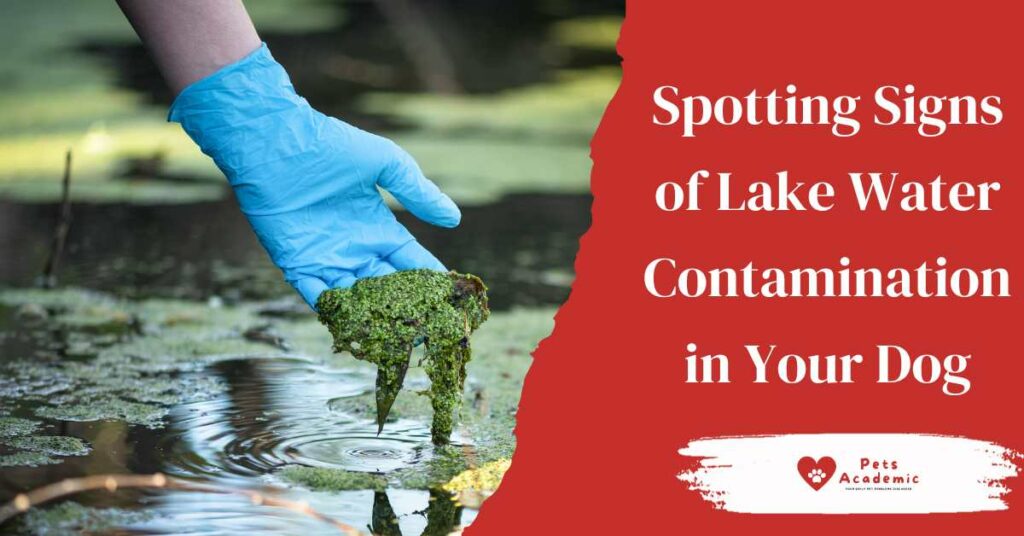
Hey there, keen-eyed pet parents! Now that we’ve covered what to watch for in terms of symptoms, let’s talk about how you can become a real-life doggy detective and spot signs of lake water contamination.
Identifying Abnormal Water Conditions: The Telltale Clues
First things first, take a good look at the water itself. Is it crystal clear, or does it have an unusual color or texture? Algae blooms, which can be harmful, often give the water a vibrant green or blue-green hue. If it looks like a paint palette gone wild, that’s your first sign to exercise caution.
Recognizing Unusual Algae Blooms: The Neon Warning Signs
Speaking of algae, if you spot what looks like a neon party happening on the water’s surface, it’s time to proceed with extra care. These colorful blooms, while beautiful in their own way, can be a sign of potentially harmful toxins lurking beneath.
Sniffing Out Strange Odors: Trust Your Nose!
Dogs have an incredible sense of smell, and guess what? So do you! Take a whiff of the air around the lake. If you catch a strong, unpleasant odor – something beyond the usual ‘lake smell’ – it might be a sign that the water is contaminated.
Remember, it’s not about being paranoid, but about being informed. Being able to spot signs of contamination can make all the difference in keeping your furry friend safe and sound during your lakeside adventures.
In the next section, we’ll dive into the preventive measures for dogs near lakes. So, stay tuned for some quick and effective doggy first aid tips!
Preventive Measures for Dogs Near Lakes
Alright, proactive pet parents, it’s time to talk prevention! We’re all about making sure your pup’s lakeside adventure is not just fun, but safe too. Here are some key steps you can take to keep potential hazards at bay:
1. Supervision and Leash Training: The Buddy System
Think of it as a buddy system for your fur baby. When you’re by the lake, keep a close eye on your pup. A well-fitted leash can be a lifesaver, especially if your dog tends to be more curious than cautious.
2. Teaching “Leave It” and “Come” Commands: The Lifesavers
These are like the golden tickets of lake safety. “Leave It” can help prevent your dog from investigating potentially harmful substances, and “Come” can get them out of a sticky situation in a jiffy. Consistent training is key here!
3. Providing Fresh Water Alternatives: The Hydration Station
Bring along a trusty water bottle and a portable bowl. This way, you’ll have a clean water source readily available for your pup. It’s like their very own hydration station, minus the lake water roulette.
Remember, a little prevention goes a long way. By setting some ground rules and having a few tricks up your sleeve, you can ensure that your lakeside escapade is nothing short of pawsitively awesome!
Conclusion
In the world of canine fun, lakes are a treasure trove of excitement. But with great adventures come great responsibilities. By understanding the potential hazards of lake water and taking proactive measures, you can ensure your furry friend’s safety and well-being.
From supervising playtime to teaching crucial commands, and providing clean water alternatives, you’re now equipped to make every lakeside excursion a memorable and safe one.
And should an unexpected sip occur, remember the swift actions and expert guidance outlined here. With your watchful eye and a touch of preventive magic, you’ll turn every lakeside day into a tail-wagging success. Happy adventuring! 🐾
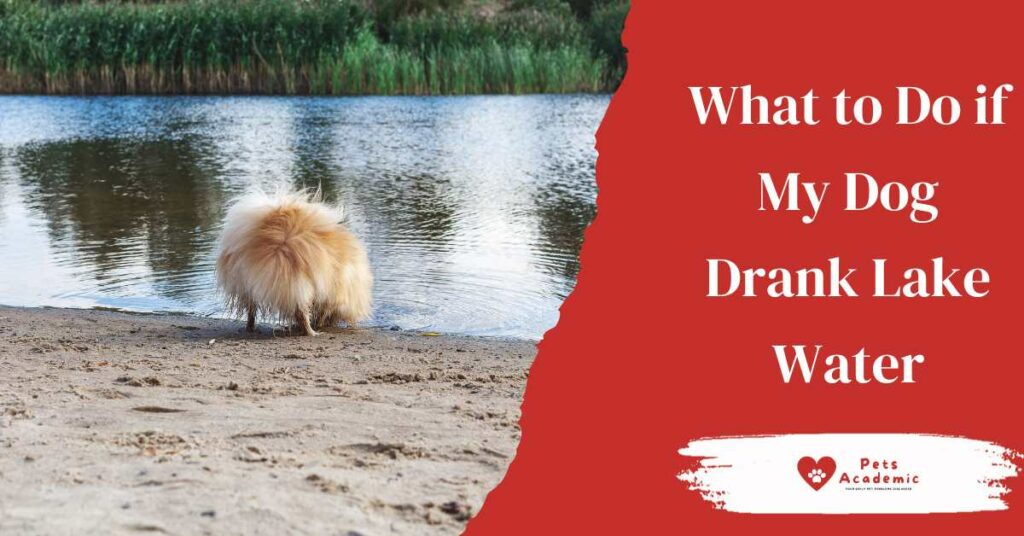
Frequently Asked Questions
- What happens if my dog drinks rainwater?
Drinking small amounts of clean rainwater is generally safe for dogs. However, stagnant or polluted rainwater can contain contaminants, potentially causing gastrointestinal upset. If your dog consumes a large amount, monitor for any signs of distress and consult a vet if concerned.
- Should I give my dog water after vomiting?
After vomiting, it’s best to withhold water for about 2 hours to allow the stomach to settle. Then, offer small, frequent sips of water. If vomiting persists or worsens, consult your vet immediately.
- Can I give my dog paracetamol?
No, you should never give your dog paracetamol (also known as acetaminophen). It can be highly toxic to dogs and lead to serious health complications, including liver damage and even death. If your dog is in pain or discomfort, consult your veterinarian for safe and appropriate pain relief options specifically designed for dogs.
Related Posts: Top 15 Extinct Bird Species You’ve Never Heard Of
